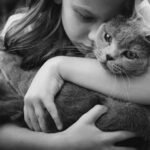Have you ever wondered why some cats seem to enjoy their solitude while others crave constant companionship? Cats, with their mysterious and independent nature, often leave us puzzled with their behavior. Some prefer to bond silently, while others revel in closeness and affection. This intriguing difference has captivated cat enthusiasts for centuries. Understanding these behaviors not only deepens our connection with these furry companions but also enriches our lives. Let’s dive into the fascinating world of feline bonding and unravel the secrets behind their silent and close-knit relationships.
The Silent Bond: Understanding Independent Cats
Cats that bond in silence often display a more independent demeanor. These felines are content with their own company and enjoy observing the world from a distance. They might sit quietly by the window, watching the birds and leaves dance in the wind. Such cats are not necessarily aloof or unfriendly; they simply find comfort in solitude. This behavior can be traced back to their wild ancestors who needed to be vigilant and self-reliant for survival. Independent cats often form deep, unspoken connections with their human companions, communicating through subtle gestures rather than overt displays of affection.
The Closeness Connection: Understanding Affectionate Cats
On the other side of the spectrum, some cats thrive on closeness and affection. These cats are the ones that greet you at the door, curl up in your lap, and follow you from room to room. They purr loudly and knead with their paws, seeking constant reassurance and love. This behavior is often seen in cats that have been well-socialized from a young age. Their desire for closeness can also be attributed to their innate need for warmth and security, reminiscent of the comfort they felt as kittens nestled against their mothers. Affectionate cats form strong bonds with their human companions, often becoming integral members of the family.
Nature vs. Nurture: The Role of Genetics and Environment
The debate between nature and nurture plays a significant role in feline behavior. Genetics can predispose a cat to be either independent or affectionate. Certain breeds, like the Siamese, are known for their social and vocal nature, while others, like the Russian Blue, are more reserved. However, a cat’s environment and experiences also shape its personality. Cats raised in loving, interactive households are more likely to develop affectionate tendencies. Conversely, cats that have experienced trauma or neglect may be more inclined towards solitude. It’s essential to recognize that each cat is a unique blend of genetics and experience, making their behavior a fascinating puzzle to unravel.
Communication Styles: How Cats Express Their Bond
Cats have a unique way of communicating their bond with humans. Those that bond in silence often use body language to express their feelings. A slow blink, gentle head butt, or a quiet presence beside you are all signs of affection. On the other hand, cats that thrive on closeness are more vocal and expressive. They may meow, purr, or even chirp to convey their emotions. Understanding these subtle cues can help strengthen the bond between you and your feline friend, ensuring a harmonious relationship.
Respecting Their Space: The Importance of Boundaries
Whether your cat is independent or affectionate, respecting their boundaries is crucial. For cats that bond in silence, providing a safe space where they can retreat and observe is essential. This might be a cozy corner with a view or a high perch where they can watch the world go by. For affectionate cats, regular playtime and cuddles can satisfy their need for interaction. It’s important to recognize and respect your cat’s unique personality, allowing them to express their bond in their own way.
Building Trust: The Foundation of a Strong Bond
Trust is the cornerstone of any relationship, and the bond with your cat is no exception. Building trust requires patience, understanding, and consistency. For independent cats, this might mean allowing them to approach you on their terms, offering gentle interactions, and respecting their need for space. For affectionate cats, trust is built through regular engagement, play, and affection. Over time, as trust deepens, the bond between you and your cat will become stronger, creating a lasting and fulfilling relationship.
Adapting to Change: How Cats React to New Situations
Cats are creatures of habit, and changes in their environment can impact their behavior. Independent cats might become more withdrawn, while affectionate cats may seek additional comfort and reassurance. It’s important to introduce changes gradually, providing familiar scents and routines to ease the transition. Whether it’s a new home, a new family member, or a change in routine, being mindful of your cat’s needs and reactions can help maintain a strong bond during times of change.
The Joy of Feline Companionship
The bond between humans and cats is a unique and rewarding experience. Whether your cat bonds in silence or thrives on closeness, the joy they bring is immeasurable. Their presence provides comfort, companionship, and endless entertainment. By understanding their behavior and respecting their individuality, we can create a nurturing environment where both humans and cats flourish. So, next time your cat curls up silently beside you or nudges you for a cuddle, cherish the moment and celebrate the special bond you share.

Growing up traveling and experiencing new cultures and wonders, I have had a passion for nature, adventuring, photography, and videography. I am currently working towards a BSc in Biodiversity and Ecology at Stellenbosch University, and I hope to specialise in Marine Sciences one day.
Please send any feedback to Feedback@animalsaroundtheglobe.com






